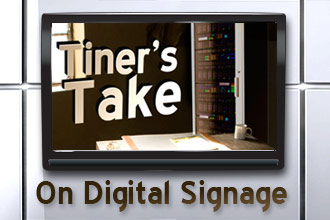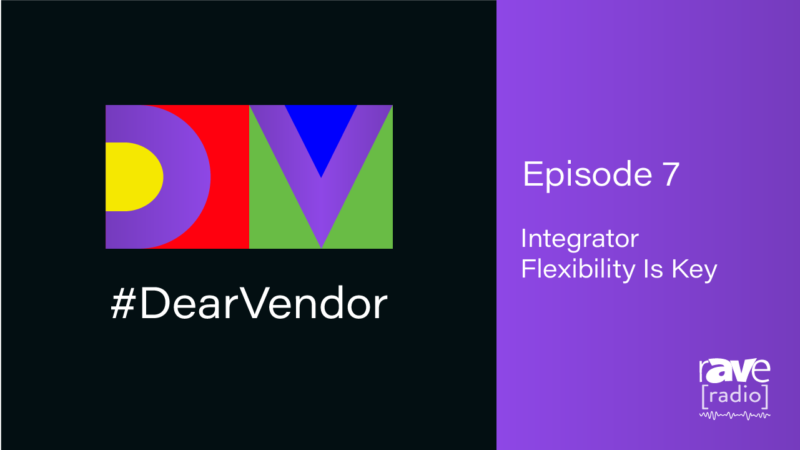Turning Digital Signage Into Ca$h
 Recently, a couple of events got me thinking about some interesting and creative ways to use digital signage in our educational facilities. The first conversation was with a colleague from George Mason University. We were talking about digital signage and he was telling me that at his location the AV department has nothing to do with the digital signs. He went on to tell me that their signs are part of a system designed by a third party company. Check out what they are doing at George Mason, by simply googling George Mason digital signage.
Recently, a couple of events got me thinking about some interesting and creative ways to use digital signage in our educational facilities. The first conversation was with a colleague from George Mason University. We were talking about digital signage and he was telling me that at his location the AV department has nothing to do with the digital signs. He went on to tell me that their signs are part of a system designed by a third party company. Check out what they are doing at George Mason, by simply googling George Mason digital signage.
There are several things I really like about what I saw on the George Mason website. First, they allow anyone on campus to post announcements, ads and other items of interest to the signs. Right on their website there are instructions on how to post an ad, etc. For on campus organizations there are no charges. It is a very easy and open system for anyone who has access to a web browser.
A few days later I was reading the student newspaper on my campus and noticed a large half-page ad for Papa John’s pizza. It was your typical targeted ad, indicating a special if you used a certain code word. That is when some things started coming together for me.
At Bates College, and many other smaller colleges, we don’t do a very good job of monetizing our signs. At my institution we don’t monetize them at all. In fact, I have written in this column before about how we need to look beyond money, and find other ways to identify total cost of ownership. It is possible, I was wrong and we need to re-assess how we manage these signs.
It seems to me that we need to follow the model that larger universities like George Mason have implemented, albeit on a smaller scale. Certainly we have students on campus who have disposable income and are interested in knowing about deals and opportunities. In previous columns I have written on targeted bulletins. This means that we identify our audience, and we identify the times that they may be near the sign.
There are some landmines particular to education that we need to be wary of before selling ads. Some pretty easy ones to think about are the content of the advertisements (e.g., schools do not want to promote alcohol use), and the timing of the advertisements (we probably don’t want to see an ad for pizza at 10 in the morning). Particularly, you need to be sensitive to why the signs were installed in the first place. They are in place to make announcements of the college, and to celebrate academic, artistic and athletic achievements. If faculty are seeing ads for restaurants, clothing stores and department stores when they expect to be seeing announcements of upcoming lectures, they may be appropriately upset.
So, one needs to be careful about how these ads are approached. A couple of suggestions: First, one of the prime target times for college age students is in the evening. They are awake and they are up and about. It is also a time that most classes are done, and the students are on their own time schedule. Second, be thoughtful about your advertisements, and make them tasteful. The faculty and staff may not be around at 10 or 11 at night, but good taste is still in order. Typical advertisements that sell with sex, tobacco or alcohol may not fly with academics.
Being creative — one can think about a lot of places to which you could sell advertisements. Our small town has a semi-professional hockey team, and our students are potentially a major customer. Using our boards to sell tickets and specials to games is a great use. We have one of the largest outdoor retailers headquartered in our state. Our student activities office regularly sends buses up to the flagship store, again, how about hitting that retailer up for some advertisements, that tie into when our buses are scheduled to go to the store?
If you are an integrator, your creative mind should be starting to hear some cash register ringing right now. Why? Two reasons: First, this is a fantastic way to sell digital signs to colleges and universities. I think there is even possibilities of using this method to sell digital signage to large high schools. People understand return on investment when you speak in real cash.
Second, what if you, as the integrator managed, and/or consulted your customer on how to sell ads and to whom to sell them? As an integrator you could offer you customer a steeply discounted digital signage install, provided that you had rights to sell and collect money for advertisements. Now obviously you would need contracts and understandings on what type of ads you could sell, when they could run and for how often. You also have people with sales experience on your payroll already. Sales is something that most schools don’t have in house expertise on. In addition, if you could develop a good relationship, with a school, or a number of schools, you have created yourself an income source for years. I think this is an example of new sources of income that integrators need to start looking into. After all, many companies already do a lot of the creative work for their digital sign customers, this is just one more step.
I also understand that this may be more to bite off than some of the smaller integrators are able to chew. So, you certainly could consult to some of your customers about this. Let them know that these possibilities exist. Show them other customers of yours who have been successful with this model. If you can not provide the direct service, being a resource to your customer will still allow you to show your value.
What are your experiences? Are you in a school that has done this successfully? Are you an integrator who works with schools on this type of solution? Let me know, I would love to follow up on your stories in future columns. I look forward to hearing from you.





